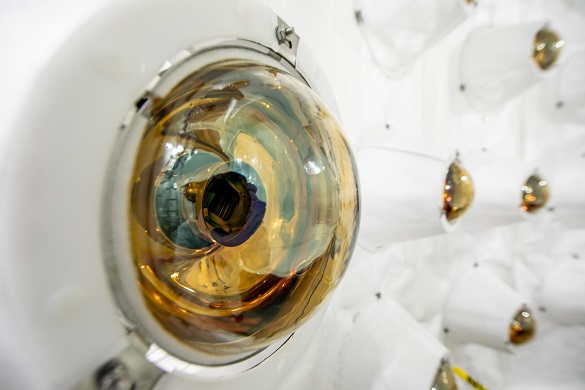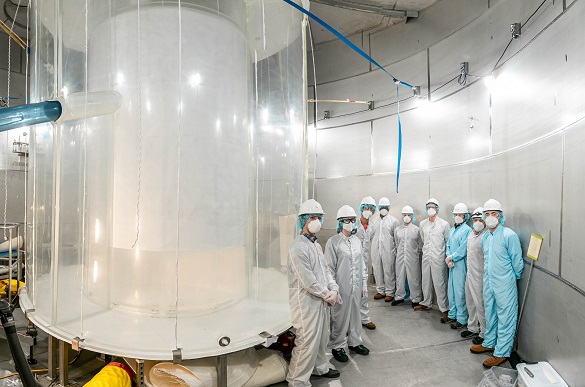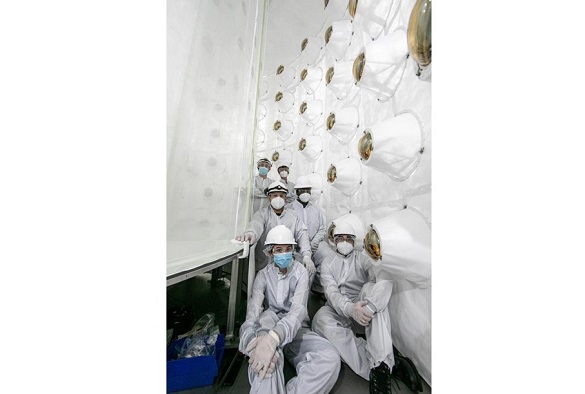
*Image credit: Matthew Kapust/Sanford Underground Research Facility
Figuring out the nature of dark matter, the invisible substance that makes up most of the mass in our universe, is one of the greatest puzzles in physics.
An international experiment called LUX-ZEPLIN (LZ), which involves University of Liverpool researchers, has produced new results which narrow down possibilities for one of the leading dark matter candidates: weakly interacting massive particles, or WIMPs.
LZ is the world’s largest and most sensitive dark matter experiment. Based at the Sanford Underground Research Facility in South Dakota in the US, LZ hunts for dark matter from a cavern nearly one mile underground.
The experiment’s new results explore weaker dark matter interactions than ever searched before and further limit what WIMPs could be.
Spokesperson for LZ, Professor Chamkaur Ghag, from University College London (UCL), said: “These are new world-leading constraints by a sizable margin on dark matter and WIMPs.” He noted that the detector and analysis techniques are performing even better than the collaboration expected. “If WIMPs had been within the region we searched, we’d have been able to robustly say something about them. We know we have the sensitivity and tools to see whether they’re there as we search lower energies and accrue the bulk of this experiment’s lifetime.”

Members of the LZ team in the LZ water tank after the outer detector installation.
Credit: Matthew Kapust/Sanford Underground Research Facility
University of Liverpool and LZ
University of Liverpool physicists have been part of the LZ collaboration since 2014 providing significant technical, hardware and software expertise to the experiment.
The Liverpool group, led by Professor Sergey Burdin from the Particle Physics Group, provided an important contribution to LZ’s latest results.
They produced the Optical Calibration System for the LZ Outer Detector with support of the Detector Development Manufacturing Facility. Liverpool postdocs and students (including both postgraduate and undergraduate students) calibrated and operated the LZ detector, led the neutron background studies, as well as development of the data analysis and monitoring frameworks.
Professor Burdin said: “Understanding the nature of dark matter is one of the most fascinating questions of fundamental science. The LZ experiment has demonstrated unprecedented sensitivity to the dark matter interactions leading the searches for Weakly Interacting Massive Particles (WIMPs) after collecting just a quarter of planned data.
“An important contribution to this sensitivity is suppression and thorough studies of the neutron background which can produce detector signals undistinguishable from the dark matter.
“The Optical Calibration System produced in Liverpool successfully operated since the start of the experiment and proved to be essential for monitoring of the LZ Outer Detector which is vital for the neutron background suppression.
“These results and expertise also pave the road to the strong contribution of our Liverpool group to the next generation dark matter search experiments, especially if such experiment will be hosted in the UK.
New results
The collaboration found no evidence of WIMPs above a mass of 9 gigaelectronvolts/c2 (GeV/c2). (For comparison, the mass of a proton is slightly less than 1 GeV/c2.) The experiment’s sensitivity to faint interactions helps researchers reject potential WIMP dark matter models that don’t fit the data, leaving significantly fewer places for WIMPs to hide.
The new results were presented at two physics conferences on August 26: TeV Particle Astrophysics 2024 in Chicago, Illinois, and LIDINE 2024 in São Paulo, Brazil. A science paper will be published in the coming weeks.
The results analyze 280 days’ worth of data: a new set of 220 days (collected between March 2023 and April 2024) combined with 60 earlier days from LZ’s first run. The experiment plans to collect 1,000 days’ worth of data before it ends in 2028.
LZ’s sensitivity comes from the myriad ways the detector can reduce backgrounds, the false signals that can impersonate or hide a dark matter interaction. Deep underground, the detector is shielded from cosmic rays coming from space. To reduce natural radiation from everyday objects, LZ was built from thousands of ultraclean, low-radiation parts. The detector is built like an onion, with each layer either blocking outside radiation or tracking particle interactions to rule out dark matter mimics. And sophisticated new analysis techniques help rule out background interactions, particularly those from the most common culprit: radon.
This result is also the first time that LZ has applied “salting”– a technique that adds fake WIMP signals during data collection. By camouflaging the real data until “unsalting” at the very end, researchers can avoid unconscious bias and keep from overly interpreting or changing their analysis.
LZ uses 10 tonnes of liquid xenon to provide a dense, transparent material for dark matter particles to potentially bump into. The hope is for a WIMP to knock into a xenon nucleus, causing it to move, much like a hit from a cue ball in a game of pool. By collecting the light and electrons emitted during interactions, LZ captures potential WIMP signals alongside other data.
Led by the US Department of Energy’s Lawrence Berkeley National Laboratory (Berkeley Lab), LZ is a collaboration of roughly 250 scientists from 38 institutions in the United States, United Kingdom, Portugal, Switzerland, South Korea, and Australia.

Researchers sit between two outer layers of LZ during construction. Credit: Matthew Kapust/Sanford Underground Research Facility
*Main image: LZ’s outer photomultiplier tubes collect light from background particle interactions.
Credit: Matthew Kapust/Sanford Underground Research Facility